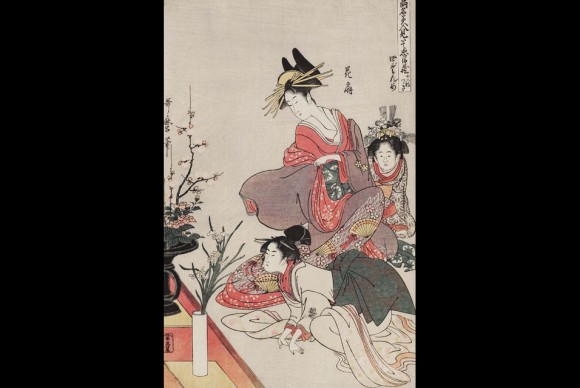Exhibition of Erotic Depictions of Men and Women Opens in Sydney
February 14, 2010 by All Art News
Filed under Art Events & Exhibitions, Featured
SYDNEY.- Whether depictions of high-ranked courtesans, diligent housewives, affectionate mothers or passionate lovers, the prints of Japanese artist, Kitagawa Utamaro (1753?-1806) have delighted audiences for over 200 years.
An exhibition of his work will be in Australia for the first time. Featuring over 80 prints from the collection of the Asian Art Museum, National Museums in Berlin, this exhibition showcases the art of Kitagawa Utamaro, one of the most well-known Japanese artists in the Western world.

Kitagawa Utamaro, Hanaogi in Act 4, from the set The Chushingura drama parodied by famous beauties: a set of twelve prints, c. 1796. Oban, color woodblock print. Asian Art Museum, National Museums in berlin
Utamaro revolutionised the way women were portrayed in Japanese visual art. Compositions of ill-fated lovers, lovers in moments of despair and mothers doting on their sons were among his favourite along with many erotic depictions of men and women, so subtle they escaped censorship at the time.
Trained in the orthodox painting style of the Kano school, Utamaro’s talent was soon discovered by Tsutaya Jûzaburô, an influential and astute ukiyo-e publisher. Under Tsutaya’s guidance, Utamaro rose quickly, achieving his first critical acclaim and commercial success with vibrant illustrations for sumptuously printed poetry anthologies and erotic books in the late 1780s. When this type of publication was censored in the early 1790s, Tsutaya and Utamaro shifted their activity to the profitable genre of ‘pictures of beautiful women’ (bijinga). The close-up view enabled him to capture a fleeting facial expression and mood and imbue his subjects with a psychological depth.
About one third of the 2000 authenticated designs by Utamaro deals with subjects related to the Yoshiwara, the licensed pleasure quarters of Edo (today’s Tokyo), including numerous portraits of its courtesans, their teenage attendants and child servants. Presented as icons of beauty and fashion trendsetters, these alluring images acted as advertisements for the women, for the establishments with which they were affiliated, and ultimately also for the artist. By acquiring these prints, the public, most of whom could hardly ever afford the company of such ‘stars’, could indulge in the illusion of being part of this exclusive world.
As well as the female inhabitants of the pleasure quarters, Utamaro portrayed women from all walks of life. In his images, diligent housewives doing daily chores or female workers of various trades were instilled with a poise and understated eroticism that matched the courtesans of the Yoshiwara. His depictions of mothers doting on their little sons and pairs of star-crossed lovers from literature and theatre are among the finest in Japanese art. Like no other artist, Utamaro understood how to visualise passion and physical intimacy between the sexes without transgressing censorship laws.
By the mid 1790s, ‘Utamaro’ was the most sought-after brand name for sensuous, passionate and technically outstanding images of beautiful women. His style set the standard for the works of his contemporaries and followers such as Eishi, Eishô, Eisui, Eiryû, Chôki and Banki, who are also presented in this exhibition.
The exhibition’s title takes its inspiration from the poem of the same name by Charles Baudelaire. Baudelaire’s adoration of beauty might well find resonance with viewers of Utamaro’s images of beautiful women.
On view at the Art Gallery of New South Wales from February 13 through May 2, 2010.
